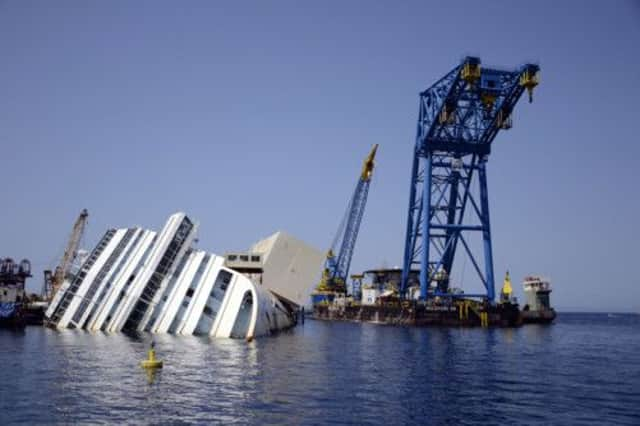Race against time for Costa Concordia salvage crew


Nick Sloane, head of the operation, yesterday said the Concordia has compressed some 10ft since it came to rest on the rocks on 13 January last year, after ramming a jagged reef during a dangerous manoeuvre allegedly ordered by the captain. Thirty-two people were killed.
Mr Sloane, an engineer for Titan Salvage, said experts would have one chance to pull the ship upright and float it away to the mainland for demolition. The attempt will probably take place in mid-September. “We cannot put it back down and start over,” said Mr Sloane.
Advertisement
Hide AdAdvertisement
Hide AdMr Sloane spoke aboard a work boat as he accompanied journalists for a close look at the wreck on the eve of the trial of Captain Francesco Schettino, who is charged with manslaughter, causing a shipwreck and abandoning the ship before all passengers had been evacuated. The trial is due to start tomorrow, after a delay due to a lawyers’ strike.
The timetable to remove the Concordia has also suffered delays. The original timetable envisioned removal before the start of this summer, but harsh weather undermined those plans.
“We had a rough winter,” said Mr Sloane, explaining that winter’s rough sea conditions made it risky for diving teams to install cement-filled bags that would provide a more stable base on which to roll the ship upright.
Mr Sloane said the granite seabed also proved more resistant to drilling than planned, “like trying to drill through glass at a 45-degree angle.”
Pressure to make the unprecedented operation succeed is high because the difficulties will only grow with time.
“Another winter and we might not be able to parbuckle,” Mr Sloane said, using the nautical term for righting a ship. He explained that the ship might compress even further, making it more difficult to right it.
The project calls for dozens of crane-like pulleys flanking the ship to slowly start tilting the vessel upright at a rate of three metres per hour.
Yesterday, welders moved across the now horizontal hull, securing the steel pieces which will function like hooks to fasten the 17,000-tonne steel chains looped under the wreck to help pull it upright. So far 18 chains have been laid, with the remaining four to be put in place over the next few days.
Advertisement
Hide AdAdvertisement
Hide AdTo work on the tilted wreck, the welders were given five days of climbing training on nearly sheer granite rocks on the island by instructors from Italy’s Dolomite mountains.
Crews are also attaching caissons, or tanks, to the exposed flank of the Concordia. The caissons will be filled with water to add weight and help pull the ship upright. Identical caissons will be attached to the submerged side of the ship once it’s righted. The caissons on both sides will then be filled with air to float the ship up off the rocks so it can be towed away.
The 70-metre-long gash on the Concordia’s hull has been largely covered with metal plates, though an exposed three-metre-wide hole remains.
Right above the tear was the passenger dining room, whose big picture windows gave diners a view of the lights of Giglio as the Concordia tried to glide close to the coast in the blackness of a winter’s night.
The ship slammed into the reef off Giglio and then capsized. Passengers described a frantic and delayed evacuation, with the bridge initially insisting the ship had merely suffered a blackout.
Bodies of two of the victims – an Italian passenger and a Filipino waiter – were never found.